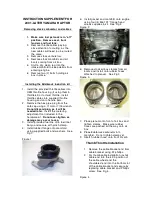
•
Always use fuel with the recommended octane rating.
•
Use a known quality gasoline, preferably a national brand.
Your results will be most accurate if your filling method is consistent.
Calculating fuel economy
1. Fill the fuel tank completely and record the initial odometer reading
(in miles or kilometers).
2. Each time you fill the tank, record the amount of fuel added (in
gallons or liters).
3. After at least three to five tank fill-ups, fill the fuel tank and record
the current odometer reading.
4. Subtract your initial odometer reading from the current odometer
reading.
5. Follow one of the simple calculations in order to determine fuel
economy:
Calculation 1:
Divide total miles traveled by total gallons used.
Calculation 2:
Multiply liters used by 100, then divide by total
kilometers traveled.
Keep a record for at least one month and record the type of driving (city
or highway). This will provide an accurate estimate of the vehicle’s fuel
economy under current driving conditions. Additionally, keeping records
during summer and winter will show how temperature impacts fuel
economy. In general, very hot or very cold temperatures give lower fuel
economy.
Driving style — good driving and fuel economy habits
Since it is able to operate in electric mode and to collect braking energy,
your hybrid vehicle will get better fuel economy in city driving than on
the highway. This is contrary to conventional vehicles. However, many of
the same actions that improve fuel economy in a conventional vehicle
will also improve fuel economy in this vehicle.
Give consideration to the lists that follow and you may be able to
improve your fuel economy.
Habits
•
Avoid aggressive driving. Quick acceleration and deceleration decrease
fuel economy.
•
Drive at a smooth, constant speed. Excessive variation in pedal input
causes more operating mode changes and reduces efficiency.
2009 Tribute Hybrid
(thv)
Owners Guide, 1st Printing
USA
(fus)
Maintenance and Specifications
289
















































